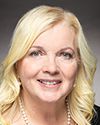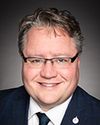Thank you.
I would now like to come back to the question asked by my colleague Ms. Shanahan—
Evidence of meeting #6 for Public Accounts in the 44th Parliament, 1st Session. (The original version is on Parliament’s site, as are the minutes.) The winning word was cunningham.
A recording is available from Parliament.
12:40 p.m.
Bloc

Nathalie Sinclair-Desgagné Bloc Terrebonne, QC
Thank you.
I would now like to come back to the question asked by my colleague Ms. Shanahan—
12:40 p.m.
Liberal

The Vice-Chair Liberal Jean Yip
I'm sorry, Ms. Sinclair-Desgagné, the time is up, and we move to Mr. Desjarlais.
12:40 p.m.
NDP

Blake Desjarlais NDP Edmonton Griesbach, AB
Thank you, Madam Chair.
I want to address this next question to Mr. Hayes, the deputy auditor general.
The report that was outlined talked about the lack of targets for inclusion, equity and diversity within PSP. We just heard from Mr. Cunningham that there were, in fact, some performance indicators or targets.
Can you just describe for me what the report published by the Auditor General states is the issue, exactly, related to how we measure or hold accountable that framework?
12:40 p.m.
Deputy Auditor General, Office of the Auditor General
Thank you.
In simple terms, they have strategic objectives to achieve. The issue we brought forward was that the targets should be more precise, specific or measurable.
What you might have heard from Mr. Cunningham—and he may be able to elaborate here—is that since the work that we have reported on, some action has been taken. We can't speak to the action that has been taken. That might be something we would look at when we go in next for either our financial audit work that's coming up or are planning later in the fall.
Mr. Cunningham might be able to add some colour there.
12:40 p.m.
NDP

Blake Desjarlais NDP Edmonton Griesbach, AB
Thank you very much.
Mr. Cunningham, could you respond directly to whether or not what the Auditor General's report is stating related to the lack of clarity on targets has been achieved by the new plan? What are those targets?
12:40 p.m.
President and Chief Executive Officer, Public Sector Pension Investment Board
Sure.
Not to sound flippant, but we take the OAG's recommendations very seriously. When this came up in the audit we said that we need to have some more specific targets. We do and that's what we reported in November. Every November we'll update the targets and report to our board of directors on progress.
12:40 p.m.
NDP

Blake Desjarlais NDP Edmonton Griesbach, AB
To be clear, are they currently in place as of that date?
12:40 p.m.
President and Chief Executive Officer, Public Sector Pension Investment Board
They are.
12:40 p.m.
NDP
12:40 p.m.
President and Chief Executive Officer, Public Sector Pension Investment Board
Officially, it's in November. This will be an annual process.
12:40 p.m.
NDP

Blake Desjarlais NDP Edmonton Griesbach, AB
Excellent.
I will follow up on that for the indicators themselves. Is the process that the board reviews the work of the internal group, which comprises folks internal to the corporation, including yourself who is a co-chair of the existing system?
12:40 p.m.
President and Chief Executive Officer, Public Sector Pension Investment Board
Not quite.
We have the EI and D council of 100 employees, which is really educational for the whole organization. Then we have our human resources team who tracks the achievement of the various diversity targets and initiatives.
It's the latter that reports to the board.
12:45 p.m.
Liberal
12:45 p.m.
Liberal

Valerie Bradford Liberal Kitchener South—Hespeler, ON
I would like to thank our witnesses for coming before us today. I congratulate you on a lovely, clean audit and great returns with low risk. As a former financial planner, I find this very reassuring.
I would also like to congratulate Mr. Cunningham on your pending, well-deserved retirement. After 19 years that's practically a life sentence. I think we can all be grateful that you did not escape early for good performance. I wish you all the best in your retirement.
This is directed to the PSPIB. It operates at arm's length from the federal government. It's not part of the federal public administration. It makes its own investment decisions. How does that ownership structure help you achieve your mandate?
I'm not sure which one of the witnesses would like to address that.
12:45 p.m.
Chair of the Board, Public Sector Pension Investment Board
I'll take that. It's Martin Glynn here. I'm the chair.
Yes, we have a very arm's-length relationship with the government, but a very good one. We have a number of mechanisms to make sure that we're on track respecting and understanding their risk appetite. We liaise with the chief actuary and many other parties.
From a point of view of independence, we have our own board of directors. There's an independent nominating committee that nominates new ones, with a search firm that assists. The result is that we have excellent candidates who are all competent and financially expert. It allows for a very high level of governance at the board.
That's essentially how we operate. It's a high-water mark of how boards in the public sector can relate.
We're very pleased with our structure, and with the co-operative and supportive nature of our relationship with TBS and the other ministries.
12:45 p.m.
Liberal

Valerie Bradford Liberal Kitchener South—Hespeler, ON
The fund's long-term target rate of return is at least 4%, and you've comfortably exceeded that, so what happens to the delta? In other words, what impact does exceeding that target have on members and the government? Would the contribution rates possibly be lowered temporarily in the future?
What are your thoughts on that?
12:45 p.m.
President and Chief Executive Officer, Public Sector Pension Investment Board
Do you want me to take that, Martin?
12:45 p.m.
President and Chief Executive Officer, Public Sector Pension Investment Board
Written into the rules is the concept of a non-permitted surplus, which is now at 125% of the long-term funding requirement for the firm. If we were to exceed that 125% funding, there are mechanisms that kick in. The time doesn't allow me to go through all of them, but basically there's the possibility of a contribution holiday or other action that the minister has the final word on regarding what action would be taken.
12:45 p.m.
Liberal

Valerie Bradford Liberal Kitchener South—Hespeler, ON
Thank you.
I will address the next couple of questions to the deputy auditor general.
According to your report, PSP investments had a procedure for validating the models used to value its financial instruments and measure the associated risk, but this procedure did not include a model risk assessment methodology or other model risk management procedures.
Can you explain in greater detail the nature of the problem identified and the measures that should be taken?
12:45 p.m.
Deputy Auditor General, Office of the Auditor General
I'm going to start with some high-level answers to that, then I might turn Madam Cabana or Ms. Loutsiv to expand.
What we found—and we reported this in paragraphs 30 and 31—was there was work to be done to set the procedures for risk assessment and to identify how the procedures for model development, ownership and maintenance, independent validation, monitoring and reporting would be done. It's not to say that they don't have a model validation procedure; it's just that there were improvements that could be made in these areas and we felt that with improvements in these areas, there could be consistency across the corporations, business units and investment units.
Ms. Cabana, would you like to add to that?
12:50 p.m.
Principal, Office of the Auditor General
I can give some examples to put it more concretely for you. One of the areas where we think it should be strengthened was, for example, when we say the model risk assessment methodology is to help classify the different models, because they're not equally critical. Also, it should define and clarify ownership, so who has the ownership of the models.
The procedure was there; it just needed some enhancement, because the model is very important for PSP.
12:50 p.m.
Liberal
February 15th, 2022 / 12:50 p.m.
Conservative

Richard Bragdon Conservative Tobique—Mactaquac, NB
Thank you, Madam Chair.
Thank you to each of the presenters today for the great work that you've done and the good reports coming out as they relate to the pension and the funds. How we wish that all statements and reports had these kinds of returns and growth projections. I want to commend you on that.
Mr. Cunningham, I believe it is you who is moving toward retirement. All that usually means is a new chapter begins, and you'll probably even get busier. It seems that way with a lot of people who move into that next chapter. Congratulations on a successful career.
I have a couple of questions I'd like to start off with. I believe I'll start with you, Mr. Hayes, or you can direct it where you wish.
With respect to corporate risk management, you found that PSP investments had not fully implemented a risk-based compliance program. Can you explain what a risk-based compliance program is? To follow up on that, what facets of the compliance program were not implemented by PSP investments?